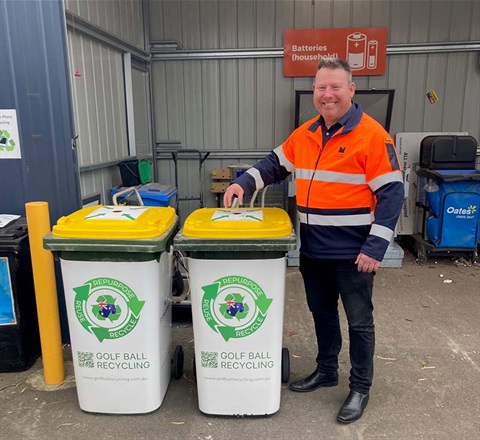
Monash Council has partnered with Notting Hill business Golf Ball Recycling (GBR) to set up collection points for old golf balls at Glen Waverley Golf Course, Oakleigh Golf Course and the Recycling and Waste Centre.
Since the trial began at Glen Waverley in May 2023, more than 12,000 golf balls have been recycled by Monash community members.
The collected balls are shredded and can be repurposed for various uses, including making golf course bridges and stormwater pit lids. In a testament to local collaboration, Mount Waverley Primary School is trialling these porous pit lids, which allow water to seep through while preventing leaves and litter from clogging the drain.
Read on for an interview with Golf Ball Recycling managing director John Harrington.
What can you tell us about Golf Ball Recycling (GBR)?
Our business is about reducing landfill and exploring what else golf can recycle.
When we started the business, there was no service to recycle end-of-life golf balls. Despite a large second-hand golf ball market, which keeps balls in circulation for longer, many end-of-life golf balls are still dumped to landfill. In Australia, New Zealand and Singapore, we found that the annual landfill could fill over 15 Olympic-sized swimming pools.
Production of one golf ball produces a cubic metre of CO₂ emissions, and millions of golf balls end up in creeks, rivers, and oceans potentially affecting marine life – some even found in the stomachs of fish.
In 2014, I thought, 'we must be able to do something about this'. In 2021, we launched a national bin service, shredding end-of-life golf balls so they can be repurposed into other products, including stormwater systems, acoustic panels, furniture, safety bollards, roadways, paving solutions and waste water drainage systems.
One driving range business was dumping more than 140,000 golf balls into landfill every year; now we are working with them to reduce their CO₂ emissions by 12 cubic tonnes per year.
By collecting and recycling golf balls back into local infrastructure, it makes people feel proud to contribute.
What is the most important change for you since you began golf ball recycling?
It has made me look at life through the lens of circularity, aiming to keep resources in use for as long as possible and designing with this in mind. I have changed habits and encourage golf clubs and businesses to reduce waste.
I am learning daily about circularity. Growing up in a large family in regional Victoria meant living resourcefully – and that is what circularity is all about.
Why is that important to you?
With 40 years in construction logistics and waste management, I've seen so much waste and products going to landfill. Making a difference matters most to me.
The golf ball recycling bin service is just the start. GBR offers waste management services to help businesses develop their own waste management policies and procedures.
However, I also encourage others to think about circularity, to make a difference and have an impact. GBR wants to encourage more clubs to embrace biodiversity and start having conversations about circularity. Hopefully this will drive change in the industry.






